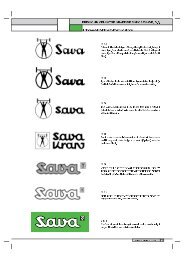Annual report 2005 - Sava dd
Annual report 2005 - Sava dd
Annual report 2005 - Sava dd
Create successful ePaper yourself
Turn your PDF publications into a flip-book with our unique Google optimized e-Paper software.
a n n u a l r e p o r t | 2 0 0 5<br />
1 5 4 |<br />
q) Revenue<br />
Goods sold and services rendered<br />
Revenue from the sale of goods is recognised in the<br />
income statement when the significant risks and rewards<br />
of ownership have been transferred to the buyer.<br />
Revenue from services rendered is recognised in the<br />
income statement as services are rendered.<br />
No revenue is recognised if there are significant<br />
uncertainties regarding recovery of the consideration<br />
due, associated costs or the possible return of goods also<br />
continuing management involvement with the goods.<br />
Construction contracts<br />
As soon as the outcome of a construction contract can be<br />
estimated reliably, contract revenue and expenses are<br />
recognised in the income statement in proportion to the<br />
stage of completion of the contract. The stage of<br />
completion is assessed by reference to surveys of work<br />
performed. An expected loss on a contract is recognised<br />
immediately as incurred.<br />
Rental income<br />
Rental income from investment property is recognised<br />
in the income statement on a straight-line basis over the<br />
term of the lease.<br />
Government grants<br />
Government grant is recognised in the balance sheet<br />
initially as deferred income when there is reasonable<br />
assurance that it will be received and that the Group will<br />
comply with the conditions attaching to it.<br />
Grants that compensate the Group for expenses incurred<br />
are recognised as revenue in the income statement on a<br />
systematic basis in the same periods in which the<br />
expenses are incurred. Grants that compensate the<br />
Group for the cost of an asset are recognised in the<br />
income statement as other operating income on a<br />
systematic basis over the useful life of the asset.<br />
r) Expenses<br />
Operating lease payments<br />
Payments made under operating leases are recognised in<br />
the income statement on a straight-line basis over the<br />
term of the lease.<br />
Net financing costs<br />
Net financing costs comprise interest payable on<br />
borrowings calculated using the effective interest rate<br />
method, interest receivable on funds invested, dividend<br />
income, foreign exchange gains and losses, and gains<br />
and losses from sale of securities.<br />
Interest income is recognised in the income statement as<br />
it accrues, using the effective interest rate method.<br />
Dividend income is recognised in the income statement<br />
on the date the entity’s right to receive payments is<br />
established.<br />
The interest expense component of finance lease<br />
payments is recognised in the income statement using<br />
the effective interest rate method.<br />
s) Income tax<br />
Income tax on the profit or loss for the year comprises<br />
current and deferred tax. Income tax is recognised in the<br />
income statement except to the extent that it relates to<br />
items recognised directly in equity, in which case it is<br />
recognised in equity.<br />
Current tax is the expected tax payable on the taxable<br />
income for the year, using tax rates enacted or<br />
substantially enacted at the balance sheet date, and any<br />
adjustment to tax payable in respect of previous years.<br />
Deferred tax is provided using the balance sheet liability<br />
method, providing for temporary differences between<br />
the carrying amounts of assets and liabilities for<br />
financial <strong>report</strong>ing purposes and the amounts used for<br />
taxation purposes. The amount of deferred tax provided<br />
is based on the expected manner of realisation or<br />
settlement of the carrying amount of assets and<br />
liabilities, using tax rates enacted or substantively<br />
enacted at the balance sheet date.<br />
A deferred tax asset is recognised only to the extent that<br />
it is probable that future taxable profits will be available<br />
against which the asset can be utilised. Deferred tax<br />
assets are reduced to the extent that it is no longer<br />
probable that the related tax benefit will be realised.<br />
t) Segment <strong>report</strong>ing<br />
A segment is a distinguishable component of the Group<br />
that is engaged either in providing products or services








